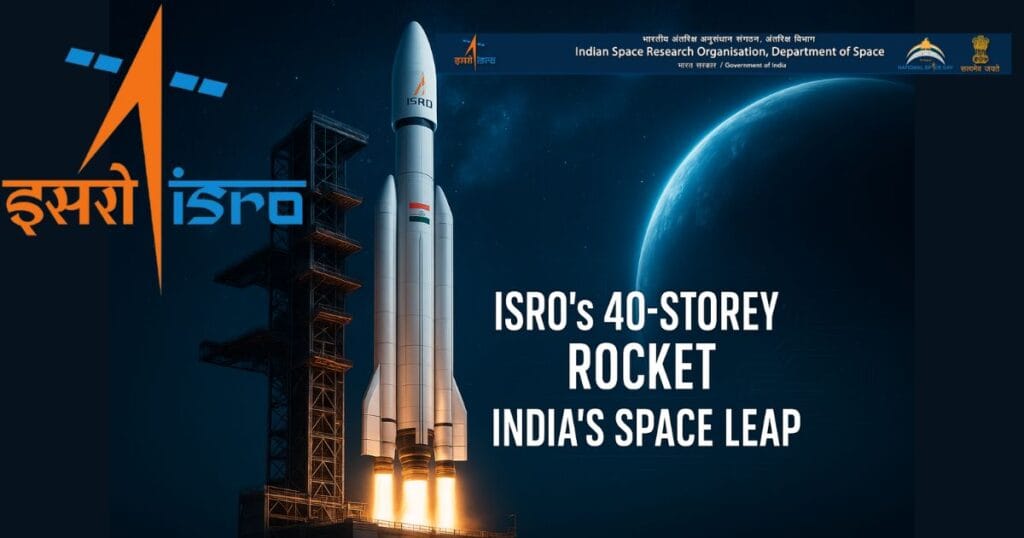Have you ever imagined a rocket so massive that it’s as tall as a 40-storey building? The Indian Space Research Organisation (ISRO) recently announced plans for such a groundbreaking project. This rocket, named N1, will stand approximately 120 meters tall and be capable of carrying 75 tons (75,000 kilograms) of payload to Low Earth Orbit (LEO). This is a historic step for India, placing it shoulder-to-shoulder with global space giants like the USA, China, and SpaceX.

When and Where Did ISRO Make This Announcement?
On August 19, 2025, during a convocation ceremony at Osmania University in Hyderabad, ISRO Chairman V. Narayanan unveiled this mega-rocket plan. He said, “Our first rocket, built by Dr. APJ Abdul Kalam, weighed just 17 tons and carried 35 kilograms to orbit. Now, we’re envisioning a 40-storey rocket that can lift 75 tons.
At the event, Telangana Governor Jishnu Dev Varma honored Narayanan with an honorary Doctor of Science. He also shared that ISRO is working on major projects this year, including NAVIC (India’s GPS-like navigation system), the N1 rocket, and GSAT-7R for the Indian Navy. Currently, India has 55 satellites in orbit, with a goal to triple this number in the next 3-4 years. This means more satellites for better weather forecasting, faster internet, and enhanced national security.
What Are the Key Features of This Rocket?
The N1 super heavy-lift rocket will be India’s most powerful rocket to date. Let’s break down its standout features in simple terms:
- 75-Ton Capacity: This rocket can carry 75,000 kilograms of payload to LEO. To put that in perspective, that’s about the weight of 15 elephants! Earlier Indian rockets could lift only 4-10 tons, so this is a massive leap.
- 40-Storey Height: At 120 meters, it’s as tall as a football stadium. It will rank among the tallest rockets globally.
- Super Heavy Class: It belongs to the elite category of rockets, alongside NASA’s SLS, SpaceX’s Starship, and China’s Long March 9. India is now joining this exclusive club.
- Advanced Technology: The rocket will have multiple stages, powered by cryogenic engines that use super-cold fuels like liquid oxygen and hydrogen. These engines are incredibly powerful.
- Versatile Missions: It will support Gaganyaan human missions, lunar or Mars missions, components for the Indian Space Station, and launching multiple satellites at once.
The biggest advantage? India will no longer rely on foreign rockets for large missions. This is a shining example of Atmanirbhar Bharat (self-reliant India) and will make India a strong player in the global space race.
What Missions Is This Rocket Designed For?
The rocket is primarily designed for Low Earth Orbit (LEO), where most satellites and space stations operate. But its strength makes it suitable for many other tasks:
- Space Station: It can carry large modules for India’s indigenous space station, planned for 2035.
- Moon and Mars Missions: It will aid in building lunar bases or sending rovers to Mars.
- Large Satellites: It can launch multiple NAVIC, communication, and observation satellites in one go.
- GEO Missions: It may also support Geostationary Orbit (GEO) missions, where satellites stay fixed relative to Earth (e.g., for TV signals).
ISRO is also exploring reusable technology, meaning the rocket could be reused to make missions cheaper and more efficient. This rocket will be a game-changer for India’s space ambitions.
What Challenges Lie in Building This Rocket?
Building such a massive rocket is no easy task. ISRO engineers will face several challenges:
- Strong Yet Lightweight Design: A 120-meter rocket must be sturdy but not too heavy. This requires composite materials and special alloys to balance strength and weight.
- Multiple Engine Coordination: The rocket will need dozens of engines working in sync. Managing vibrations, heat, and fuel distribution is a major hurdle.
- Launch Pad Upgrades: The current launch site at Sriharikota will need upgrades, including new cranes, larger fuel tanks, and noise suppression systems, as launches create intense sound and flames.
- Safety and Navigation: Real-time control with systems like NAVIC and GPS, along with robust safety measures, is critical to handle emergencies.
These challenges will test ISRO’s grit and innovation. But with successes like Chandrayaan and Mangalyaan, we know they can pull it off!
When Will This Rocket Be Ready?
The rocket is in its early development phase, with no fixed launch date yet. Here’s a likely roadmap:
- Research and Design: ISRO is working on designs, simulations, and prototypes.
- Small-Scale Tests: Testing engines and systems with smaller models.
- Static Fire Tests: Ground-based engine tests to check stability and safety.
- First Flight: If all goes well, a test launch could happen in 3-5 years.
In 2025, ISRO plans 9 launches, including PSLV N1 and an uncrewed Gaganyaan test. This rocket will become the star of India’s space program in the next decade.
How Will It Impact India’s Economy and Industry?
This rocket isn’t just a scientific marvel—it’s a game-changer for India’s economy and industry:
- Private Sector Opportunities: ISRO will partner with private startups to build rocket parts and join the supply chain, fostering new companies.
- Jobs and Investment: India’s space sector is already a $60 billion industry, employing 4.7 million people. This rocket will create more jobs, especially in tech and manufacturing.
- Supply Chain Boost: Demand for metals, electronics, and testing tools will grow, strengthening the industry.
- Social Benefits: Better internet, weather forecasts, and disaster management will improve lives.
This project will bring India closer to the Atmanirbhar Bharat vision and elevate our space industry on the global stage.
How Does It Compare to Global Rockets?
Let’s compare the N1 with other major rockets:
- SpaceX Starship: 120 meters, 100-150 tons payload, fully reusable. Designed for Mars and Moon missions.
- NASA SLS: 111 meters, 42 tons payload, cryogenic engines, for lunar and Mars missions.
- Roscosmos Angara/Energia: 55-60 meters, 24-100 tons, older tech, less competitive.
- ISRO N1: 120 meters, 75 tons payload, focused on low cost and self-reliance.
ISRO’s strength lies in its cost-effectiveness and innovation. While behind in reusability, this rocket will make India a formidable player in the global space market.
What About Environmental Impact?
Rocket launches pose environmental challenges:
- Emissions: Rockets release CO2, water vapor, and particles that can harm the ozone layer.
- Noise Pollution: The loud launch noise can affect local wildlife and vegetation.
- Debris: Rocket stages falling into the sea or land can cause pollution.
However, ISRO is working on reusable technology, low-pollution fuels, and better launch pad designs to minimize impact. Environmental studies at Sriharikota will help control effects.
ALSO READ- CMO-DA: NASA & Google’s AI Healthcare Assistant for Space Missions
How Will This Benefit the Public?
This rocket will bring tangible benefits to people:
- Better Internet and TV: Large satellites will improve connectivity and broadcasting.
- Disaster Management: Advanced observation satellites will provide accurate data for floods, earthquakes, and more.
- Scientific Discoveries: Large telescopes and research tools in space will lead to new findings.
- Space Station: It will pave the way for India’s own space station by 2035.
India’s Role in the Global Launch Market
The global satellite launch market is worth $20 billion, with India holding a 2% share. ISRO aims to increase this to 10%. So far, ISRO has launched 430 satellites for 34 countries, earning over ₹3100 crore. This rocket will attract more international clients, making India a cost-effective and reliable launch provider.
Will this rocket carry humans?
It’s currently for satellites and modules, but could be adapted for human missions later.
When is the first test?
Likely in 3-5 years.
Is it reusable?
Not yet, but ISRO is working on it.
What’s the payload capacity?
75 tons.
Conclusion: India’s Space Future
ISRO’s 40-storey rocket will give wings to India’s space dreams. It will make us self-reliant, boost our global market share, and deliver better services to the public. Keep an eye on ISRO’s website and news updates. This rocket is India’s pride and an inspiration for the next generation!
SOURCES- Moneycontrol, ISRO


